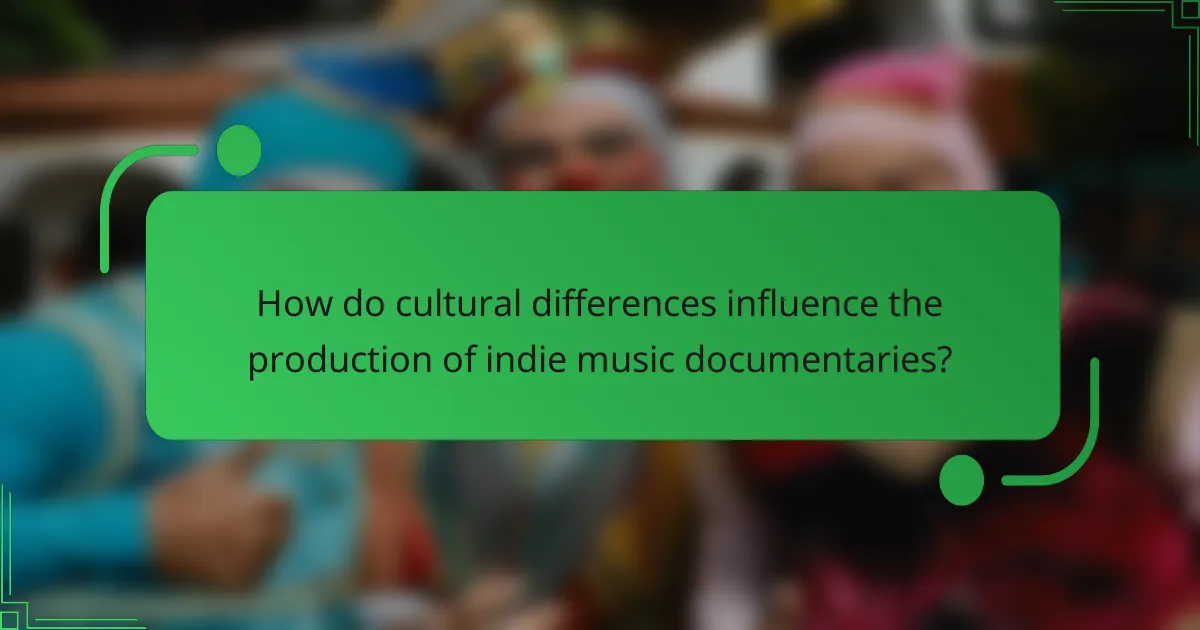Indie music documentaries provide valuable insights into the lives and struggles of independent artists. They highlight unique narratives, showcase cultural impact, and explore notable films like “20 Feet from Stardom” and “Searching for Sugar Man.” These documentaries reveal the creative processes behind the music, the challenges filmmakers face, and the ways audiences engage with this genre. By emphasizing authenticity and storytelling, they foster a deeper appreciation for the indie music landscape.

What defines the essence of indie music documentaries?
Indie music documentaries capture the spirit of independent artists, showcasing their creativity and challenges. They emphasize authenticity, often highlighting unique narratives and grassroots movements. Notable releases like “20 Feet from Stardom” and “Searching for Sugar Man” illustrate the impact of indie music on culture. These films often reveal personal stories, making the genre relatable and inspiring.
How do indie music documentaries differ from mainstream film productions?
Indie music documentaries differ from mainstream film productions primarily in their creative freedom and focus on niche subjects. Indie documentaries often explore personal stories and unique perspectives, whereas mainstream productions tend to prioritize broader appeal and commercial viability.
Indie films typically have lower budgets, allowing for experimental storytelling techniques and authenticity. This results in raw, intimate portrayals of artists and genres that may not receive attention from larger studios. Notable indie documentaries like “20 Feet from Stardom” highlight underrepresented voices in the music industry, contrasting with mainstream films that often feature well-known figures.
Additionally, indie documentaries can afford to be more critical and honest about the music industry, addressing issues like exploitation and diversity. This contrasts with the polished narratives often found in mainstream productions, which may sanitize or simplify complex realities.
What are the common themes explored in indie music documentaries?
Indie music documentaries often explore themes of artistic authenticity, the struggles of independent artists, and the impact of music on culture. They highlight personal stories, community connections, and the evolution of music genres. Additionally, many documentaries examine the relationship between artists and their audiences, showcasing how indie music fosters a sense of belonging. These films frequently emphasize the DIY ethos, illustrating how artists navigate challenges in the music industry while remaining true to their vision.

Why are indie music documentaries significant in the music industry?
Indie music documentaries are significant in the music industry as they provide unique insights into the creative processes and struggles of artists. They highlight the diverse narratives often overlooked in mainstream media, showcasing the cultural impact of indie music. Documentaries like “20 Feet from Stardom” and “Searching for Sugar Man” illustrate the challenges and triumphs of lesser-known musicians, fostering a deeper appreciation for their contributions. These films also serve as a platform for emerging artists, helping to connect them with audiences and industry professionals.
How do these documentaries influence public perception of artists?
Indie music documentaries significantly shape public perception of artists by providing intimate insights into their lives and creative processes. These films often humanize artists, showcasing their struggles and triumphs, which fosters a deeper connection with audiences. As a result, viewers may develop a more empathetic understanding of the artists’ motivations and artistry. Documentaries like “20 Feet from Stardom” and “Searching for Sugar Man” exemplify this impact, highlighting unique attributes of lesser-known musicians and elevating their public profiles. Such narratives can transform how audiences perceive not just the artists, but also the broader indie music scene.
What role do indie music documentaries play in promoting emerging genres?
Indie music documentaries significantly promote emerging genres by showcasing unique artists and their stories. These films provide a platform for lesser-known musicians, helping to cultivate interest and awareness among audiences. They often highlight the cultural and social contexts of these genres, making them more relatable. For instance, documentaries like “20 Feet from Stardom” and “Searching for Sugar Man” have introduced audiences to new sounds and perspectives, driving genre popularity and growth. As a result, indie music documentaries are crucial in shaping the music landscape.

Which notable indie music documentaries have shaped the genre?
Several notable indie music documentaries have significantly shaped the genre, including “Searching for Sugar Man,” “20 Feet from Stardom,” and “American Hardcore.” These films explore the lives of musicians, the cultural impact of indie music, and the challenges faced by artists outside the mainstream. “Searching for Sugar Man” highlights the story of Rodriguez, whose music gained unexpected fame in South Africa. “20 Feet from Stardom” showcases the vital yet often overlooked contributions of backup singers in shaping iconic tracks. “American Hardcore” documents the punk rock movement’s influence on indie music, emphasizing its DIY ethos and cultural significance. Each documentary offers a unique perspective on the indie music landscape, influencing both audiences and aspiring musicians.
What are the key takeaways from ’20 Feet from Stardom’?
The key takeaways from “20 Feet from Stardom” highlight the importance of backup singers in the music industry. The documentary showcases their talent, struggles, and the vital role they play in shaping songs. It emphasizes their often-overlooked contributions and the emotional depth they bring to performances. The film also features personal stories that illustrate the unique journeys of these artists, revealing the challenges they face in gaining recognition. Overall, it sheds light on the unsung heroes of music, celebrating their artistry and impact.
How did ‘Searching for Sugar Man’ impact the narrative of music storytelling?
“Searching for Sugar Man” transformed music storytelling by highlighting underrepresented artists and their journeys. The documentary showcased the unique narrative of Sixto Rodriguez, whose music resonated in South Africa despite his obscurity in the U.S. This film emphasized the power of storytelling in indie music documentaries, illustrating how personal narratives can impact broader cultural conversations. It also inspired a resurgence of interest in Rodriguez’s work, demonstrating the rare ability of documentaries to revive forgotten talent and connect audiences across different contexts. The film’s success sparked discussions about authenticity, legacy, and the role of music in social movements, reinforcing the importance of diverse voices in the music industry.

How do cultural differences influence the production of indie music documentaries?
Cultural differences significantly shape the production of indie music documentaries by influencing storytelling, aesthetics, and audience engagement. Documentaries reflect the cultural context of the artists, showcasing unique musical styles and narratives. For instance, regional music traditions impact the themes and visuals presented. Collaborations with local filmmakers enhance authenticity, allowing diverse perspectives to emerge. Cultural nuances also affect marketing strategies, tailoring content to resonate with specific audiences. This interplay enriches the indie documentary landscape, fostering a deeper connection between music and culture.
What unique storytelling techniques are prevalent in European indie music documentaries?
European indie music documentaries often utilize unique storytelling techniques that emphasize authenticity and emotional connection. These films frequently incorporate personal narratives from artists, providing intimate glimpses into their creative processes and struggles.
Another prevalent technique is the use of visual metaphors and symbolism, enhancing the thematic depth of the story. This approach allows filmmakers to convey complex emotions and concepts through imagery, making the narrative more engaging.
Additionally, many documentaries leverage a non-linear storytelling format, which can create a more immersive experience. This structure often mirrors the unpredictability of the indie music journey, reflecting the artists’ evolution over time.
Finally, sound design plays a crucial role, with carefully curated soundtracks that complement the visuals. This technique not only enhances the emotional impact but also reinforces the connection between the music and the artists’ stories.
How do North American indie music documentaries reflect regional music scenes?
North American indie music documentaries showcase regional music scenes by highlighting local artists and cultural influences. These films often emphasize the unique sounds, stories, and community connections that define each area’s music landscape. For instance, documentaries from the Pacific Northwest often explore the grunge movement, while Southern films may delve into Americana and roots music.
Notable releases like “American Hardcore” and “Searching for Sugar Man” have significantly impacted the perception of regional genres. They illustrate how place shapes musical identity and creativity, revealing the rich tapestry of indie music across North America. These documentaries not only document history but also foster appreciation for diverse musical expressions.

What challenges do filmmakers face in producing indie music documentaries?
Filmmakers face numerous challenges in producing indie music documentaries, including limited budgets, securing rights to music, and navigating distribution channels. These constraints often hinder creative freedom and access to resources. Additionally, establishing connections with artists and maintaining authenticity while appealing to broader audiences can be difficult. The unique attribute of indie documentaries is their focus on underrepresented genres and stories, which can pose both an opportunity and a challenge in finding an audience.
How do budget constraints affect documentary storytelling?
Budget constraints significantly impact documentary storytelling by limiting resources, which influences creative choices. Filmmakers often rely on innovative techniques to convey powerful narratives despite financial limitations. This can lead to unique storytelling approaches, such as utilizing available local talent or focusing on intimate, personal stories that resonate deeply. Notable indie music documentaries exemplify this, showcasing how constraints can enhance creativity and authenticity in storytelling.
What are the common technical limitations encountered during production?
Common technical limitations during the production of indie music documentaries include budget constraints, limited access to high-quality equipment, and challenges in securing distribution. These factors often restrict the scope and quality of the final product. Additionally, time constraints can hinder thorough research and editing, impacting storytelling depth. Finally, technical skills may vary among crew members, affecting the overall production quality.

How can audiences engage with indie music documentaries?
Audiences can engage with indie music documentaries through streaming platforms, film festivals, and community screenings. These documentaries often showcase unique stories and perspectives, enhancing viewer appreciation for indie music culture. Interactive Q&A sessions with filmmakers and musicians can deepen engagement. Social media discussions and online forums also allow fans to share insights and connect over shared interests.
What platforms are best for discovering indie music documentaries?
Streaming platforms are best for discovering indie music documentaries. Services like Netflix, Amazon Prime Video, and Hulu offer a range of indie music films. Additionally, dedicated platforms such as DocuBay and Kanopy focus on documentary content, including indie music. YouTube is also valuable for independent filmmakers sharing their work. Each platform provides unique selections and accessibility for diverse audiences.
How can viewers support indie filmmakers and their projects?
Viewers can support indie filmmakers by engaging with their projects through financial contributions, sharing content, and participating in events. Financial backing is crucial; platforms like Kickstarter and Indiegogo enable direct support. Sharing trailers, social media posts, and reviews amplifies visibility. Attending film festivals and screenings fosters community and networking opportunities. These actions not only enhance project reach but also contribute to the sustainability of indie filmmaking.

What best practices should filmmakers follow when creating indie music documentaries?
Filmmakers creating indie music documentaries should prioritize authenticity, storytelling, and audience engagement. Focus on the artist’s journey and unique experiences to create a compelling narrative.
Incorporate high-quality visuals and sound to enhance the emotional impact. Use interviews and behind-the-scenes footage to provide depth. Collaborate with musicians to ensure accurate representation of their artistry.
Engage with the audience through social media and screenings to build a community around the documentary. Consider festival circuits for wider exposure and recognition. These practices lead to impactful and memorable documentaries.
How can effective storytelling enhance viewer engagement?
Effective storytelling significantly enhances viewer engagement in indie music documentaries by creating emotional connections. It immerses audiences in narratives that resonate with their experiences or aspirations. This approach can highlight unique artist journeys, showcasing their struggles and triumphs, which fosters empathy and interest. Engaging storytelling also encourages viewers to reflect on broader themes such as identity and community, deepening their connection to the music. As a result, documentaries that prioritize storytelling often achieve higher viewer retention and social sharing, amplifying their impact.
What are the most common mistakes to avoid in documentary production?
The most common mistakes to avoid in documentary production include inadequate research, poor storytelling, and neglecting audience engagement. These pitfalls can undermine the impact of indie music documentaries.
Inadequate research leads to inaccuracies, affecting credibility. Poor storytelling can result in a disjointed narrative, making it difficult for viewers to connect. Neglecting audience engagement often results in a lack of interest, diminishing the documentary’s reach and influence.
Producers should prioritize thorough research, focus on a cohesive narrative structure, and actively consider audience perspectives to enhance the overall quality and effectiveness of their films.



